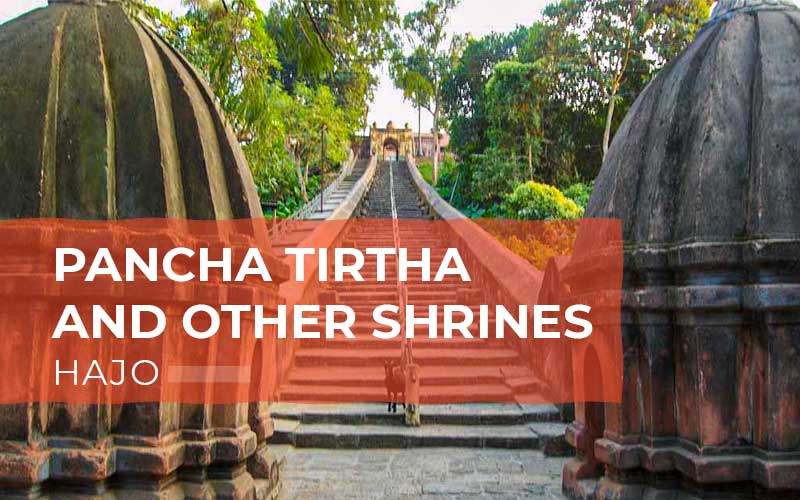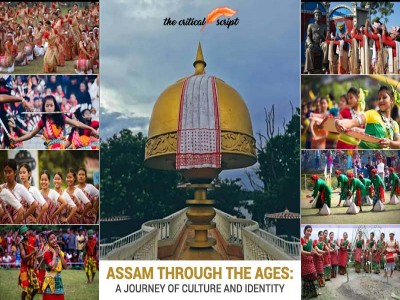
PANCHA TIRTHA AND OTHER SHRINES - HAJO
Across the river, the Brahmaputra, 36 kilometers to the northwest of Guwahati, lies the town of Hajo. The place is considered a sacred site for Hindus, Buddhists, and Muslims, and is known as PanchaTirtha or "five pilgrimages."
There are several legends associated with Hajo's religious significance. It is believed that the Pandavas visited Hajo during their exile and installed a Shiva Linga (a symbol of Lord Shiva) there.
Hajo is home to several important religious sites, including the
HayagrivaMadhava Temple, Kedareswara Temple (dedicated to Lord Shiva), the
Ganesha Temple, and the Poa Mecca Mosque (believed this mosque contains the
sacred soil of the original Mecca). The diversity of these sacred sites has led
to Hajo being considered a symbol of religious harmony and coexistence.
Hajo was under the rule of different
royal powers from the early period of history to the late medieval period. It
was an important seat of the rule of three powerful royal camps of medieval
Assam. i.e., the Koches, Mughals and the Ahoms. The religious and political
importance of Hajo brought people belonging to various
and even conflicting faiths together so as to build up a magnificent
social-cultural heritage in the area.
Major Shrines and Temples of Hajo:
HAYAGRIVA MADHAVA:
Hayagriva Madhava is the most important temple of Hajo. The temple is
situated at the top of a hillock called Manikut. The present building of the
temple was constructed by the koch king Raghudeva Narayana in 1583 A.D.
However, the original temple was constructed, in all probability, in the 6th -
7th century A.D.
The temple of Hayagriva-Madhava is said to be one of the oldest centers
of worship of Vishnu in his Hayagriva form. Again, from the days of yore, it has
been regarded by the Buddhists to be one of the most holy places connected with
the life of the Buddha. Many Buddhist people as well as some scholars believe
that the Buddha attained his mahaparinirvana where in the present Hajo area. In
winter, a large number of Buddhist pilgrims from different parts of the world
visit Hajo. They claim the image of Buddha and call it Mahamuni. It is to be
noted that both the Hindus and the Buddhist offer prayer in the temple
according to their own rites and customs.
KEDARESWAR TEMPLE:
The second important Hindu Temple is dedicated to Kedareswar or Kedar
Siva. It finds mention both in the KalikaPurana and the Jogini Tantra. The main
Idol of Kedara is a big linga of stone. It is called a svayambhulinga. This
linga appears to be an ardhanariswara form of Lord Siva.
The linga kept always covered with a big metal bowl. It is difficult to
ascertain the date of construction or to name the founder of the main building
of the temple. In 1753 A.D. King RajeswaraSingha adjoined two walls in the
gateway of the temple.
KAMALESWARA TEMPLE:
The temple of Kamaleswara was one of the prominent Siva temples of Hajo
in the past. The kalikapurana and the Jogini Tantra have made special mention
of this temple. Today the temple has lost its past glory and become a
subordinate institution of the Kedara Temple.
GANESHA TEMPLE:
At the foot of the temple is the temple of Ganesha. On a giant elephant
shape natural rock, King PramattaSingha constructed the temple building in 1744
A.D. The temple processes a big image of Lord Ganesha carved out on the
elephant-shaped rock. This temple is called Deva Bhavana and is the meeting
place of the other deities of the panchatirtha on special occasions.
DURGA TEMPLE:
There is another important Hindu temple dedicated to Durga, the mother
Goddess. The temple was built by King LakshinathSingha in 1774 A.D. There is a
ten-armed stone image of Durga on its altar.
POA-MECCA:
Poa-mecca, the holy shrine of the Muslims, stands at the top of the
Gorudachal hill. This is the tomb of the pioneer of the Muslim religion in this
area, PirGhiyasuddinAuliya. In 1657 AD, Sujauddin Muhammad Shah built this
mosque. There is more than one legend connected with the name poa-mecca and its
founder. It is considered the most holy Islamic shrine in the region. Thousands
of pilgrims from different parts of the country as well as outside visit this
holy place. People believe that visit to poa-mecca confers one-fourth of the
merits obtained from a pilgrimage to Mecca itself. Hindu pilgrims of the
locality also visit the shrine.
DHOPARGURI SATRA:
DhoparguriSatra is a famous satra of Hajo. The satra was established by
Madhavadev in 1587 A.D. He made Lakshmikanta the Acharya of the Satra. Gokarna,
Vikarna, Swargdwar, etc. are scattered in various localities of the scared
complex.
Hajo offers a glimpse into the region's rich cultural and religious
heritage through its ancient temples, mosques, and traditional crafts. Visitors
and devotees alike seek out Hajo to experience India's cultural and religious
diversity and vibrancy, as it is a site of spiritual and cultural significance.
Disclaimer: The opinions expressed in this article are those of the author's. They do not purport to reflect the opinions or views of The Critical Script or its editor.

Newsletter!!!
Subscribe to our weekly Newsletter and stay tuned.

















Related Comments